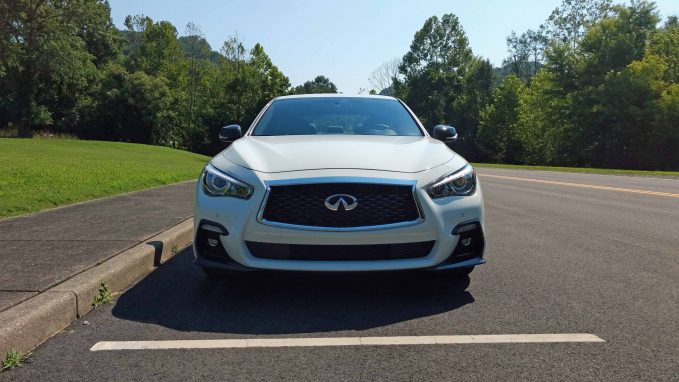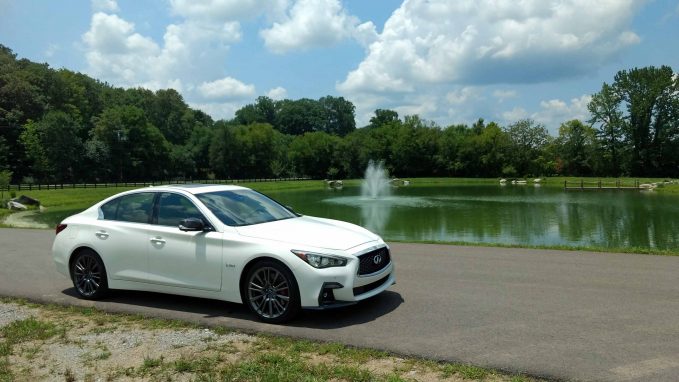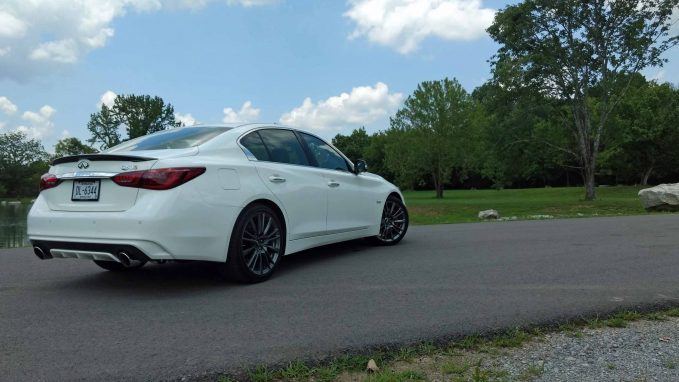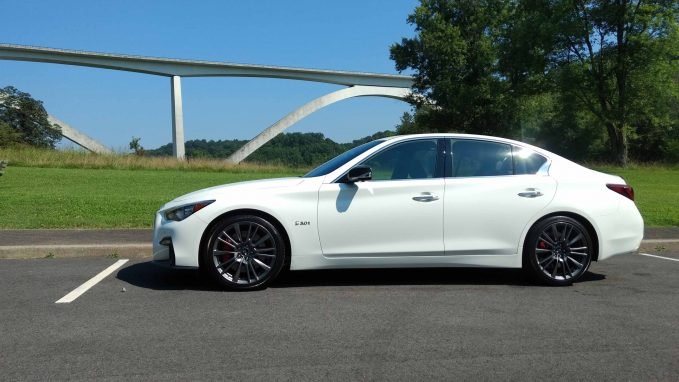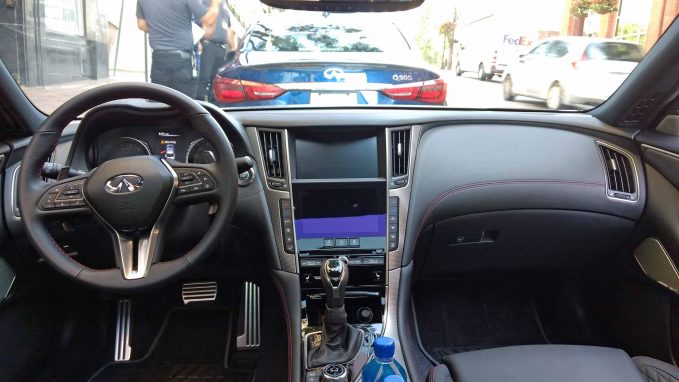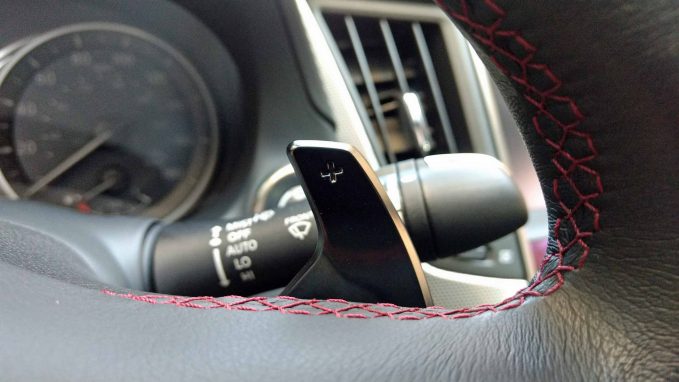When you hold the key to an Infiniti Q50, you’re holding the key to something that’s not only gorgeous but something that promises advanced technology and high levels of performance.
It is, however, important to know that the car is only its best when things line up just right, which doesn’t happen often enough.
That’s the lesson learned after driving the mildly refreshed 2018 Infiniti Q50S Red Sport 400 around Nashville and the surrounding area. The Japanese sport sedan gets a completely restructured trim lineup this year that still tops out with the Red Sport 400 model that we tested. If you don’t want a car with all the brute force of that top-end version (not to mention the price tag associated with it) you can opt for the Pure model, which starts at $35,150 and packs a 2.0-liter four-cylinder engine. Making just 208 hp and 258 lb-ft of torque, buyers can get a bit more equipment by jumping up into the Luxe model.
But these models might be lacking a bit in the oomph department, so you can swap out the four-cylinder for a twin-turbo six-cylinder that makes 300 horsepower. A car with that kind of power needs a bit more style and presence, so buyers can opt for the Sport package, which ups the visual appeal of the vehicle. Blacked-out trim bits and a larger lower intake bring out the Q50’s true intention, which is to be a fun, aggressive sport sedan.
The six-cylinder vehicles start at $39,900 and the Sport trim costs $41,600. From there, you have to pony up more than $10,000 to get an extra 100 horsepower in the Red Sport 400 we tested. Starting at $51,950, this is supposed to be the truest form of the powerful Infiniti sedan, one that combines the Japanese automaker’s motorsport heritage and success to make a bold, exciting luxury vehicle. Each trim level and engine option of the vehicle can be equipped with all-wheel drive if the rear-wheel setup isn’t appealing to you, but in Canada, each car comes with four driven wheels. Paired with each engine is a seven-speed transmission.
Tweaked Styling
The 2018 Infiniti Q50 Red Sport not only packs a wonderfully powerful and smooth engine that really punches above its output ratings, but it also has a few more exterior touches like black accents on the doors and mirrors to go along with fancier exhaust tips and a rear diffuser.
ALSO SEE: Next Infiniti QX80 Could Arrive Without V8 Power
Truthfully, it’ll be tough to spot a 2018 model over a 2017 model, but there are subtle changes. Our tester had the optional carbon fiber trim that covers the mirrors and places a subtle spoiler on the trunk decklid. The vehicle also packed the standalone exhaust upgrade, which helps to address concerns from the original launch of the Red Sport 400, where it was noted that the vehicle doesn’t sound like the 400 horsepower monster it is. Additionally, 20-inch wheels are available in case the 19 inchers aren’t big enough for you. The tail lights as well are updated, looking more like the Q60 Coupe. One last exterior styling addition for 2018 is a shade of flashy brown paint called “Mocha Almond.”
Same Bones and Heart
Under the hood, the cars are identical to last year’s model. The VR-series six-cylinder engines share some lineage with the engine found in the Nissan GT-R and the 400-horsepower model has a lot of extra tweaks to make it responsive and exciting to drive. It can end up feeling more like a muscle car than a luxury vehicle with high, license-suspending speeds popping up with little effort.
The seven-speed transmission isn’t the most refined unit and the pairing with the impressive engine is a bit like Oscar and Felix. While the e
ngine is smooth, the transmission is constantly seeking the right gear to be in. This trait is much more noticeable in the Sport and Sport+ drive modes, as every graze of the right pedal is met with an anxious downshift. But then in a moment, the cogswapper bumps back into a high gear before you’re done with it. It’s inconsistent and baffling, especially for a vehicle with sporting intentions.
Basically, it can act fun for short periods of time, but stringing together the turns in your favorite countryside route won’t be as enjoyable as it would be in a true sports car. Fortunately, the car packs a manual mode and decent feeling paddle shifters, which can help keep you in command of the gear changes. The exhaust upgrade is definitely noticeable and although there’s a bit of a drone when cruising with a light throttle application, the car definitely sounds aggressive and sporty, which will appeal to some sport sedans buyers.
Digital Steering, Suspension
In addition to the carryover powertrain, the Q50 still uses Direct Adaptive Steering, which is a completely digital, steer-by-wire system. The downside to this system is that it provides no feedback, but it features great weight and the steering ratio can be changed as you see fit. Otherwise, the ratio changes automatically to make low-speed driving easy and higher speeds precise and direct. You can also custom tailor the driving experience by mixing and matching the different steering, throttle and suspension settings to create an individual mode.
Handling is kind of surprising when you consider the vehicle weighs just under 4,000 lbs and doesn’t use a physical connection between the steering wheel and front axle (there’s a redundancy in place in case of an emergency glitch or issue, helping to appease the luddites in the luxury car buyer world). Besides the transmission issues, the car is smooth and premium feeling. Thanks to the dynamic adaptive suspension, there’s no slop or looseness in the way the car drives, it feels planted and confident. Don’t mistake this for the light and playful experience that some other sport sedans promote, as the Q50 feels like a substantial luxury vehicle.
Changes Inside
Besides restructuring the trim lineup, Infiniti spent some time refreshing the interior of the vehicle. The shift knob and steering wheel have been replaced with new units that we first saw in the Q60 coupe and there’s nicer stitching found on the dash and other materials. Interior accents are dark chrome and carbon fiber-themed, and the seats feature quilted leather with red stitching. The lighter leather and silver optic trim found in the Q60 wasn’t on display in the sedan and that’s a bit of a letdown. The gauge cluster gets a revised look with different fonts and coloring.
Another loss is that the infotainment system hasn’t been refined. Infiniti uses a somewhat confusing two-screen setup and there’s no Android Auto or Apple CarPlay support. There’s also a new upgraded sound system called Bose Performance Series, which helps to enhance the sound quality in the cabin. Overall, the cabin feels a bit dated, but fit and finish is fine.
Cabin noise is nice and isolated. There’s no wind noise and tire noise is kept at bay for the most part. It’s really nice how the sport sedan never feels crashy or overly stiff on the road. It’s refined through and through.
Finally, the vehicle packs an incredible amount of safety features and driver assistance systems. They’re extremely well executed and the adaptive cruise control and lane keep functions are among the best in the industry. When a few of these systems aren’t put into the active settings, however, they can be a bit too proactive, making the lane departure warning system beep and buzz as you graze the lane markings. Also, a byproduct of the dated infotainment system is that the displays are kind of small and you don’t see as many details when using the cameras to place your car in a parking spot.
The Verdict: 2018 Infiniti Q50 Review
Infiniti didn’t rewrite its sports sedan for 2018. In fact, it barely changed a thing, which isn’t ideal since most of its German competitors are so good. The Mercedes C-Class and Audi A4/S4 are both considerably more modern than this Japanese luxury car, but the Infiniti still has them beat on power, style, and value. The sports sedan is still a powerful, refined option in the segment for those who aren’t sold on the usual German suspects.







